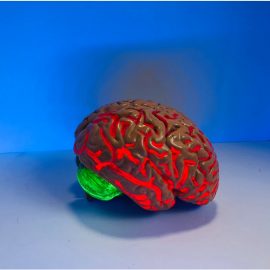

This article is an excerpt from the Shortform book guide to "A Brief History of Time" by Stephen Hawking. Shortform has the world's best summaries and analyses of books you should be reading.
Like this article? Sign up for a free trial here .
Are black holes consistent with the second law of thermodynamics? Do they have entropy?
For a time, scientists thought black holes had no entropy because they didn’t emit radiation. However, Stephen Hawking realized that, if black holes emit Hawking radiation, then they have a measurable temperature, and so their entropy can also be measured.
Read more to learn about black hole thermodynamics.
Black Hole Thermodynamics
In addition to the predictions of quantum mechanics, Hawking argues that the concept of Hawking radiation is compelling because it would make black holes consistent with the second law of thermodynamics. For a time, scientists thought black holes might be an exception to the second law of thermodynamics, but Hawking radiation would eliminate this contradiction.
According to Hawking, the second law of thermodynamics states that the total entropy of the universe (or any other closed system) is always increasing. He explains that “entropy” is basically a measure of disorder, so the total disorder in the universe is always increasing.
| While all scientists agree on the mathematical formula of the second law of thermodynamics, there is some disagreement about the best way to define “entropy” qualitatively or intuitively. Equating entropy to disorder as Hawking does is arguably the most common definition. Another common perspective is that entropy is a measure of how difficult it is to harness or direct the energy of a system. This definition aligns the second law more closely with the first law of thermodynamics, which states that energy is always conserved. As an illustration, gasoline molecules have a lot of energy stored in their chemical bonds with relatively low entropy. When you burn the gas in an engine, its chemical energy changes into heat and mechanical energy, and its entropy increases. After you burn it, its energy is all still there (in the hot exhaust, the moving engine, and so forth) but you’ve expended its useful energy. |
In regard to black hole thermodynamics, Hawking points out that, for a time, scientists thought black holes had no entropy because they didn’t emit radiation and thus had no observable temperature. The higher the temperature of an object, the more thermal radiation it gives off. The entropy of an object also increases as its temperature increases. Thus, as Hawking notes, an object that emits no radiation would have no temperature and no entropy.
Hawking then describes what happens if a piece of matter that has a certain temperature, and thus a certain amount of entropy, falls into a black hole: As soon as it crosses the event horizon, we can’t observe its entropy anymore. It’s as if its entropy has been erased from the universe—which, according to the second law of thermodynamics, shouldn’t be possible because the law says entropy is always increasing, never decreasing.
However, Hawking realized that if black holes emit Hawking radiation, then they have a measurable temperature, and so their entropy can also be measured.
He came to this realization when he developed a theoretical proof that the area of the event horizon around a black hole could increase but not decrease. Hawking saw a parallel between this property of event horizons and the second law of thermodynamics, which states that total entropy cannot decrease. When Hawking published this observation, a grad student named Jacob Bekenstein suggested that maybe you could measure the entropy of a black hole by measuring the area of the event horizon.
(Shortform note: To complete the logic a bit more than Hawking does, recognize that the amount of Hawking radiation given off by a black hole would be proportional to the area of its event horizon. This is because Hawking radiation is caused by quantum fluctuations, which occur randomly distributed throughout space. So the larger the area of the event horizon, the more quantum fluctuations will occur there in a given period of time. If the amount of Hawking radiation it gives off is proportional to the area of the event horizon, and radiation is also proportional to temperature, and temperature is proportional to entropy, then the entropy of a black hole is proportional to the amount of Hawking radiation coming from it.)
| Temperature, Entropy, and Black Holes Hawking makes reference to the relationship between temperature and entropy, but he doesn’t explain this relationship in detail. Let’s back up and discuss this relationship so we can show how it ties into Hawking’s discussion of black holes. The exact relationship between temperature and entropy is defined by the second and third laws of thermodynamics. Specifically, part of the second law states that the change in entropy of a substance or system is equal to the thermal energy that is transferred to it, divided by its absolute temperature. For example, it takes about 333 joules (J) of energy to melt a gram of ice, and ice melts at zero degrees celsius, or 273 kelvin (K), so melting a gram of ice increases its entropy by 333 J / 273 K, or about 1.22 J/K. However, the second law only defines the change in entropy for thermodynamic processes. The third law defines absolute entropy, by establishing that the entropy of a pure element or compound is zero when its temperature is absolute zero (zero kelvin) and it is in the form of a perfect crystal. If the substance has impurities or irregularities in its crystal structure, such that its molecular structure is more disordered, then it retains a small amount of entropy, even at absolute zero. So, if you want to calculate the absolute entropy of something, you use this as a starting point, and then you calculate the change in entropy to get it to its current state and temperature. For example, the heat capacity of a gram of ice is about 2.093 J/K, so it takes about 571 J to warm a 1g ice crystal from 0 to 273k. The average temperature during this process would be 273/2 K, so the change in entropy would be about 4.18 J/K. When it melts, that adds another 1.22 J/K, so the absolute entropy of a gram of water at 273 K is about 5.4 J/K. You can find the total entropy of a system by adding up the entropy of its parts. So, if a gram of water with a temperature of 273 K falls into a black hole, the entropy of the black hole must increase by 5.4 J/K, according to the laws of thermodynamics. The additional mass of the water increases the mass of the black hole, which increases its gravity, which in turn increases the size of its event horizon. The larger event horizon produces more Hawking radiation, so, theoretically, you can measure the increase in the black hole’s entropy by the increase in Hawking radiation when the water falls in. |

———End of Preview———
Like what you just read? Read the rest of the world's best book summary and analysis of Stephen Hawking's "A Brief History of Time" at Shortform .
Here's what you'll find in our full A Brief History of Time summary :
- The search for a theory that explains the history and evolution of our universe
- Stephen Hawking's discussions about time, space, dimensions, and quantum theory
- How time travel would theoretically work






